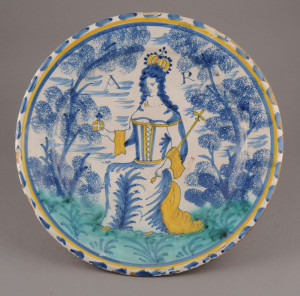Reading Museum and Art Gallery has a rich and diverse collection of art, artifacts and natural history which illustrate life and culture from the local area and from around the world. The Town Hall, library and museum complex is located in the centre of the Berkshire town and was built in stages between the 18th and 20th centuries. Visitors to the buildings, with a façade by Waterhouse, can see remarkable range of objects. These include ancient artifacts from the local town of Calleva Atrebatum , principally the Silchester Eagle, a collection of over 300 biscuit tins which celebrate the history of the town’s famous local firm, Huntley & Palmer and a full scale Victorian reproduction of the Bayeaux Tapestry.
Visitors with an interest in ceramics are rewarded with an equally mixed bag of ancient and modern wares. Particularly notable of the room dedicated to local potter Alan Caiger-Smith of the Aldermaston Pottery and a remarkable collection of Hungarian lustre wares from the Zsolnay factory, Pecs. Less well known is a group of predominantly English delftwares and other tin-glazed earthenware which comprises over 200 pieces from the 17th and 18th centuries. This collection will be the subject of my lecture to the English Ceramic Circle on the 15th March.
Much of the collection was from the collection of Harry Blatch, a member of a local brewing family. Part of the collection was donated in two tranches by Blatch in 1928 and by his nephew Ernest in 1961. The collection includes an impressive group of blue-dash chargers, royal commemorative wares, utility and decorative pieces of form. The Blatch collection was examined by Professor F.H. Garner but sadly little has been recorded and less is known of the collectors. However, some of the pieces bear labels which, in some cases, records intriguing provenance.
The Museum collection includes some notable examples of Dutch delft and a small but unusual group of Italian maiolica pharmaceutical ceramics. The group also includes tiles and decorative wares from revivalist makers of the 19th century. The collection of English wares is relatively unknown to collectors and academics today. I hope to show that the collection perhaps deserves wider recognition.


